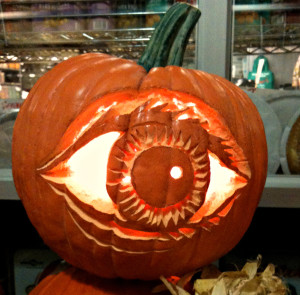 The story goes that the Jack-O’-Lantern comes from a legend that goes back hundreds of years in Irish history. It’s said that a miserable old drunk named Stingy Jack — who liked to play tricks on his family, friends, and even the Devil — tricked the Devil into climbing up an apple tree. Stingy Jack then put crosses around the apple tree’s trunk so the Devil couldn’t get down — but made a bargain that if the Devil promised not to take Stingy Jack’s soul when he died he would remove the crosses and let the Devil down.
The story goes that the Jack-O’-Lantern comes from a legend that goes back hundreds of years in Irish history. It’s said that a miserable old drunk named Stingy Jack — who liked to play tricks on his family, friends, and even the Devil — tricked the Devil into climbing up an apple tree. Stingy Jack then put crosses around the apple tree’s trunk so the Devil couldn’t get down — but made a bargain that if the Devil promised not to take Stingy Jack’s soul when he died he would remove the crosses and let the Devil down.
When Jack died, Saint Peter, at the pearly gates of Heaven, told him that he couldn’t enter Heaven because he was mean, cruel, and had led a miserable and worthless life. Stingy Jack then went down to Hell but the Devil wouldn’t take him in. Ultimate payback! Jack was scared and with nowhere to go he had to wander around in the darkness between Heaven and Hell.
Stingy Jack, Jack-o-Lanterns, and Halloween
Halloween, or the Hallow E’en in Ireland and Scotland, is short for All Hallows Eve, or the night before All Hallows. On All Hallows Eve the Irish made Jack-O’-Lanterns by hollowing out turnips, rutabagas, gourds, potatoes, and beets and put lights in them to keep away both the evil spirits and Stingy Jack. In the 1800′s when Irish immigrants came to America, they discovered that pumpkins were bigger and easier to carve, and the pumpkin became the Jack-o’-lantern.
If You Want To Eat Your Pumpkin . . .
Jumping from legend to fact: pumpkins are Cucurbitaceae, a family of vegetables that includes cucumbers and melons. They are fat free and can be baked, steamed, or canned.
One cup of pumpkin has about 30 calories, is high in vitamin C, potassium, dietary fiber, and other nutrients like folate, manganese, and omega 3′s. Pumpkin is filled with the anti-oxidant beta-carotene, which gives it its rich orange color. It can be used many ways and can be added to baked goods and blended with many foods. Pumpkin seeds are delicious and are a good source of iron, copper, and zinc. Although pumpkin is low in calories, pumpkin seeds aren’t. They have 126 calories in an ounce (about 85 seeds) and 285 calories in a cup.
Has Your Perfect Pumpkin Ever Caved In?
You can buy pumpkins to cook the pumpkin flesh or toast the seeds but most of us buy pumpkins to use as jack-o’-lanterns or for decoration.
Many commercially available “Halloween” pumpkins are specifically grown to be oversized, thin-walled, with a huge seed pocket and a relatively small proportion of flesh, perfect for carving funny or scary faces.The smaller sugar pumpkins have more fleshy pumpkin meat for cooking and often have better flavor and texture.
What To Look For When You Pick Your Pumpkin
Because pumpkins come in many sizes, shapes, and colors it’s easy to let your inner artist have free reign.
Some pumpkin tips:
- Pick a pumpkin with no cuts, bruises, or soft spots and with flesh that feels hard and doesn’t give easily. According to a pumpkin grower at my local farmers’ market, organisms can easily get inside any cut in the flesh – even a small nick — and cause rot so your perfect pumpkin will be great one day and the next day it has totally caved-in on itself.
- My farmers’ market source also told me that pumpkins can heal – if you see a cut in the flesh, expose the cut to air and keep it dry.
- There’s some chance that if your pumpkin is greenish in color you can leave it in a cool dry spot – not refrigerated – and it will ripen and turn orange.
- A pumpkin’s stem should be attached, but don’t pick it up by its stem. Stems break off easily and can leave potential entry spots for organisms to invade and cause the dreaded pumpkin cave-in.
- Gently tap your pumpkin and listen for how hollow it sounds. Lift it to get an idea of how dense it is. The heavier a pumpkin is, the thicker its walls. For a jack-o’-lantern, thick walls will block the candlelight and no one will be able to see your fantastic (or maybe not so fantastic) carving.
- Tall, oblong-shaped pumpkins are often stringier inside — which makes it difficult to make precise cuts.
- Store your pumpkin carefully, especially if you pick it off the vine. You can toughen-up, or cure, a fresh-picked pumpkin by keeping it in a dry place without handling or disturbing it. Curing toughens the rind and makes it less prone to rot.
After The Carving . . .
A carved pumpkin starts to dry and shrivel up as soon as it’s cut and exposed to air.
To keep your jack-o’-lantern fresh longer:
- Keep it cool and out of direct sunlight
- Spray it with an anti-transpirant (like Wilt-Pruf and other brands).
- If you’re having a party or just want a big “reveal,” drape your pumpkin with a damp towel until just before show time.
- Protect your masterpiece from animals who might find it appealing.
- Don’t leave your jack-o’-lantern outside if there’s a threat of frost.